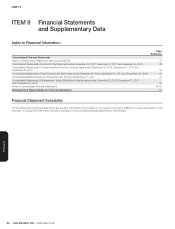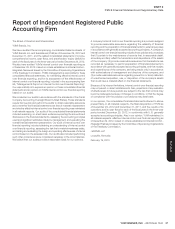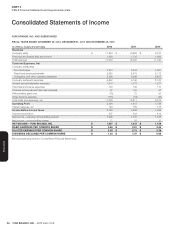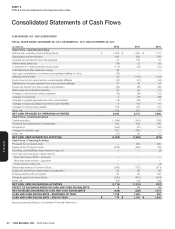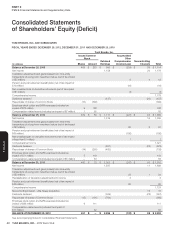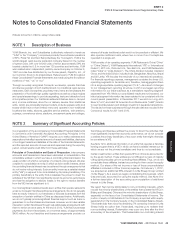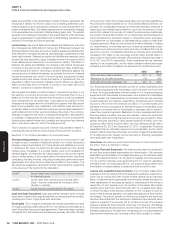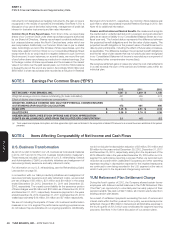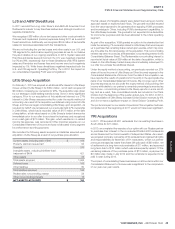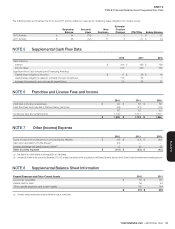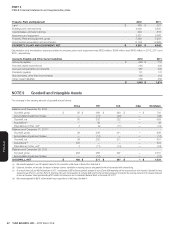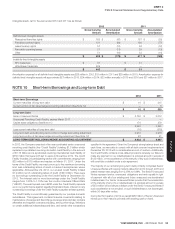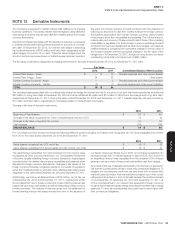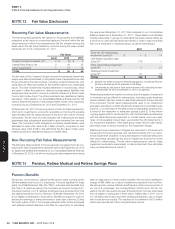Pizza Hut 2012 Annual Report Download - page 138
Download and view the complete annual report
Please find page 138 of the 2012 Pizza Hut annual report below. You can navigate through the pages in the report by either clicking on the pages listed below, or by using the keyword search tool below to find specific information within the annual report.
YUM! BRANDS, INC.-2012 Form10-K 46
Form 10-K
PART II
ITEM 8Financial Statements andSupplementaryData
leases as a condition to the refranchising of certain Company restaurants.We
recognize a liability for the fair value of such lease guarantees upon
refranchising and upon subsequent renewals of such leases when we
remain contingently liable.The related expense and any subsequent changes
in the guarantees are included in Refranchising (gain) loss.The related
expense and subsequent changes in the guarantees for other franchise
support guarantees not associated with a refranchising transaction are
included in Franchise and license expense.
Income Taxes.We record deferred tax assets and liabilities for the future
tax consequences attributable to temporary differences between the
fi nancial statement carrying amounts of existing assets and liabilities and
their respective tax bases as well as operating loss, capital loss and tax
credit carryforwards.Deferred tax assets and liabilities are measured using
enacted tax rates expected to apply to taxable income in the years in which
those differences are expected to be recovered or settled.The effect on
deferred tax assets and liabilities of a change in tax rates is recognized
in income in the period that includes the enactment date.Additionally,
in determining the need for recording a valuation allowance against the
carrying amount of deferred tax assets, we consider the amount of taxable
income and periods over which it must be earned, actual levels of past
taxable income and known trends and events or transactions that are
expected to affect future levels of taxable income.Where we determine
that it is more likely than not that all or a portion of an asset will not be
realized, we record a valuation allowance.
We recognize the benefi t of positions taken or expected to be taken in our
tax returns in our Income tax provision when it is more likely than not (i.e. a
likelihood of more than fi ftypercent) that the position would be sustained
upon examination by tax authorities.A recognized tax position is then
measured at the largest amount of benefi t that is greater than fi ftypercent
likely of being realized upon settlement.We evaluate these amounts on
a quarterly basis to insure that they have been appropriately adjusted for
audit settlements and other events we believe may impact the outcome.
Changes in judgment that result in subsequent recognition, derecognition
or a change in measurement of a tax position taken in a prior annual period
(including any related interest and penalties) are recognized as a discrete
item in the interim period in which the change occurs.
The Company recognizes accrued interest and penalties related to
unrecognized tax benefi ts as components of its Income tax provision.
See Note17 for a further discussion of our income taxes.
Fair Value Measurements.Fair value is the price we would receive to sell
an asset or pay to transfer a liability (exit price) in an orderly transaction
between market participants.For those assets and liabilities we record
or disclose at fair value, we determine fair value based upon the quoted
market price, if available.If a quoted market price is not available for
identical assets, we determine fair value based upon the quoted market
price of similar assets or the present value of expected future cash fl ows
considering the risks involved, including counterparty performance risk if
appropriate, and using discount rates appropriate for the duration.The
fair values are assigned a level within the fair value hierarchy, depending
on the source of the inputs into the calculation.
Level 1 Inputs based upon quoted prices in active markets
for identical assets.
Level 2 Inputs other than quoted prices included within
Level 1 that are observable for the asset, either
directly or indirectly.
Level 3 Inputs that are unobservable for the asset.
Cash and Cash Equivalents.Cash equivalents represent funds we have
temporarily invested (with original maturities not exceeding three months),
including short-term, highly liquid debt securities.
Receivables.The Company’s receivables are primarily generated as a result
of ongoing business relationships with our franchisees and licensees as a
result of franchise, license and lease agreements.Trade receivables consisting
of royalties from franchisees and licensees are generally due within 30 days
of the period in which the corresponding sales occur and are classifi ed as
Accounts and notes receivable on our Consolidated Balance Sheets.Our
provision for uncollectible franchise and licensee receivable balances is
based upon pre-defi ned aging criteria or upon the occurrence of other
events that indicate that we may not collect the balance due.Additionally,
we monitor the fi nancial condition of our franchisees and licensees and
record provisions for estimated losses on receivables when we believe
it probable that our franchisees or licensees will be unable to make their
required payments.While we use the best information available in making
our determination, the ultimate recovery of recorded receivables is also
dependent upon future economic events and other conditions that may be
beyond our control.Uncollectible franchise and license trade receivables
consisted of $1million in net recoveries and $7million and $3million in
net provisions which were included in Franchise and license expenses in
2012, 2011 and 2010, respectively.Trade receivables that are ultimately
deemed to be uncollectible, and for which collection efforts have been
exhausted, are written off against the allowance for doubtful accounts.
2012 2011
Accounts and notes receivable $ 313 $ 308
Allowance for doubtful accounts (12) (22)
Accounts and notes receivable, net $ 301 $ 286
Our fi nancing receivables primarily consist of notes receivables and
direct fi nancing leases with franchisees which we enter into from time
to time.As these receivables primarily relate to our ongoing business
agreements with franchisees and licensees, we consider such receivables
to have similar risk characteristics and evaluate them as one collective
portfolio segment and class for determining the allowance for doubtful
accounts.We monitor the fi nancial condition of our franchisees and
licensees and record provisions for estimated losses on receivables when
we believe it probable that our franchisees or licensees will be unable to
make their required payments.Balances of notes receivable and direct
fi nancing leases due within one year are included in Accounts and Notes
Receivable while amounts due beyond one year are included in Other
assets.Amounts included in Other assets totaled $18million (net of an
allowance of $3million) and $15million (net of an allowance of $4million)
at December29, 2012 and December31, 2011, respectively.Financing
receivables that are ultimately deemed to be uncollectible, and for which
collection efforts have been exhausted, are written off against the allowance
for doubtful accounts.Interest income recorded on fi nancing receivables
has traditionally been insignifi cant.
Inventories.We value our inventories at the lower of cost (computed on
the fi rst-in, fi rst-out method) or market.
Property, Plant and Equipment.We state property, plant and equipment
at cost less accumulated depreciation and amortization.We calculate
depreciation and amortization on a straight-line basis over the estimated useful
lives of the assets as follows: 5 to 25 years for buildings and improvements,
3 to 20 years for machinery and equipment and 3 to 7 years for capitalized
software costs.As discussed above, we suspend depreciation and
amortization on assets related to restaurants that are held for sale.
Leases and Leasehold Improvements.The Company leases land,
buildings or both for nearly 6,700 of its restaurants worldwide.Lease terms,
which vary by country and often include renewal options, are an important
factor in determining the appropriate accounting for leases including the
initial classifi cation of the lease as capital or operating and the timing of
recognition of rent expense over the duration of the lease.We include
renewal option periods in determining the term of our leases when failure
to renew the lease would impose a penalty on the Company in such an
amount that a renewal appears to be reasonably assured at the inception
of the lease.The primary penalty to which we are subject is the economic
detriment associated with the existence of leasehold improvements which
might be impaired if we choose not to continue the use of the leased
property.Leasehold improvements, which are a component of buildings
and improvements described above, are amortized over the shorter of their
estimated useful lives or the lease term.We generally do not receive leasehold
improvement incentives upon opening a store that is subject to a lease.


